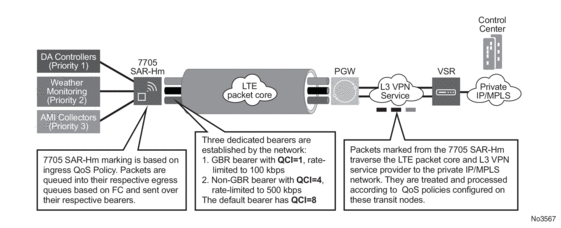11. Quality of Service
The 7705 SAR-Hm series of routers supports Quality of Service (QoS) as covered in the topics listed below:
11.1. QoS Policies
For general information on QoS policies support, refer to the topics listed below in the “QoS Policies” chapter of the 7450 ESS, 7750 SR, 7950 XRS, and VSR Quality of Service Guide.
- QoS Overview
- Forwarding Classes
- Queue Parameters
- QoS Policies Overview
- Service versus Network QoS
- QoS Policy Entities
- Network QoS Policies
- Network Queue QoS Policies
- Service Ingress QoS Policies
- Service Egress QoS Policies
- Configuration Notes
11.2. Network QoS Policies
This section describes the following functionality:
For general information on network QoS policies support, refer to the topics listed below in the “Network QoS Policies” chapter of the 7450 ESS, 7750 SR, 7950 XRS, and VSR Quality of Service Guide.
- Network QoS Policies Overview
- Network Ingress
- Network Ingress Tunnel QoS Override
- Network Ingress IP Match Criteria
- Network Egress
- Basic Configurations
- Service Management Tasks
- Network QoS Policy Command Reference
For descriptions of network QoS policy commands, refer to the 7450 ESS, 7750 SR, 7950 XRS, and VSR Classic CLI Command Reference Guide and to the 7450 ESS, 7750 SR, 7950 XRS, and VSR Clear, Show, and Tools Command Reference Guide.
11.2.1. Dedicated Bearers
A default bearer is established when the node first attaches to a cellular network for each cellular port that has an enabled SIM. An IP address is assigned for each default bearer and the node uses this IP address for the associated PDN router interface that is used to route traffic to and from the cellular network. See the PDN Router Interfaces section for information about PDN router interfaces and IP address assignment.
In addition to the default bearer, the node accepts network-initiated dedicated bearer establishment. The node does not initiate dedicated bearers towards the network.
Dedicated bearers provide a dedicated tunnel for specific types of traffic depending QoS requirements. Since they are established for the same cellular port as the default bearer, dedicated bearers use the same PDN router interface configured for the default bearer for sending and receiving traffic. Dedicated bearers can be a guaranteed bit rate (GBR) or non-GBR, whereas the default bearer can only be non-GBR. Dedicated bearers use traffic flow templates (TFTs) to provide special treatment to specific services that need to use the dedicated bearers.
The network programs TFTs on the cellular interface for each dedicated bearer. The TFTs contains at least one and up to eight packet filter items as follows:
- source address (with subnet mask)
- IP protocol number (TCP, UDP)
- destination port range
- source port range
- IPSec Security Parameter Index (SPI)
- type of Service (TOS) (IPv4)
- Flow-Label (IPv6 only)
- evaluation precedence index
The node expects only one TFT to be programmed by the network for each dedicated bearer. More than one TFT per dedicated bearer is not supported.
The node expects that the TFT programmed per dedicated bearer will contain only a TOS packet filter. Other TFT parameters, if they are specified and programmed, are not supported. The TOS packet filter enables mapping of egress packets that match the TOS settings to the corresponding dedicated bearer and provide GBR, or non-GBR, service for the traffic as required.
Operators must coordinate with their wireless service providers and subscribe for dedicated bearers with the specific TOS packet filter settings as required. Operators must then ensure that service ingress classification and marking for the respective traffic flows match the dedicated bearer TOS packet filter when services traffic must egress the radio interface on the dedicated bearer.
Figure 16 illustrates a typical use case for dedicated bearers to differentiate services over a cellular network.
Figure 16: Dedicated Bearer and Differentiated Services over a Cellular Network

The CLI output below shows an example of bearer information configured on a cellular port.
11.3. Network Queue QoS Policies
For general information on network queue QoS policies support, refer to the topics listed below in the “Network Queue QoS Policies” chapter of the 7450 ESS, 7750 SR, 7950 XRS, and VSR Quality of Service Guide.
- Basic Configurations
- Default Network Queue Policy Values
11.4. Service Ingress and Egress QoS Policies
For general information on service ingress and egress QoS policies support, refer to the topics listed below in the “Network Queue QoS Policies” chapter of the 7450 ESS, 7750 SR, 7950 XRS, and VSR Quality of Service Guide.
- Basic Configurations
- Service Ingress QoS Policy
- Service Ingress QoS Queue
- Ingress Forwarding Class (FC)
- Ingress IP Match Criteria
- Ingress IPv6 Match Criteria
- Service Egress QoS Policy
- Service Egress QoS Queue
- Percent-rate Support
- Egress SAP FC and FP Overrides
- Dot1p Egress Remarking
- DSCP/Prec Egress Remarking
- Service Management Tasks
For descriptions of service ingress and egress QoS policy commands, refer to the 7450 ESS, 7750 SR, 7950 XRS, and VSR Classic CLI Command Reference Guide and to the 7450 ESS, 7750 SR, 7950 XRS, and VSR Clear, Show, and Tools Command Reference Guide.